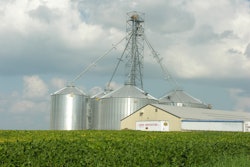In late February, grain elevator operators descended upon the land of bourbon and thoroughbreds for the 2013 edition of the GEAPS Exchange. The event, held at the Kentucky International Convention Center in the heart of Louisville, featured a diverse line-up of educational sessions, which tackled many of the industry’s critical issues, and a trade show with more than 300 exhibitors eager to showcase their latest equipment.
GEAPS Exchanges focus on education and information that provide “take home” value. Three concurrent session tracks focused on many different topics; however, the sessions Feed & Grain attended focused three main areas: safety, what’s new and transportation issues.
The following is a brief re-cap of these sessions.
Preventing catastrophic events
In the workshop, “Preventing Catastrophic Events at Your Grain Facility,” attorney Mark Aljets, of Nyemaster Goode, a law firm in Iowa, explained that he’s not a safety expert. He has, however, toured facilities to see first-hand issues that can lead to a catastrophe, he has experience in reviewing what contributed to grain facility explosions, has been involved in four litigations triggered by grain facility catastrophes, and reviewed more than 150 depositions “from guys shoveling grain to CEOs.”
Because of this unique perspective, he urged managers to take responsibility for establishing a “culture of safety” in their grain operation. Here’s a quick review of some of his recommendations and reminders:
- Someone in each facility must know “backwards and forwards” NFPA 61
- Managers must ensure that written policies are in place for housekeeping procedures and preventive maintenance of equipment
- Demand compliance; regularly review housekeeping and maintenance log sheets
- Develop and implement an employee-training program. At the very least it must cover:
- Recognition and preventive measures for hazards related to dust accumulations
- Common ignition sources
- Specific procedures and safety practices applicable to their job tasks, including housekeeping procedures, hot work procedures and preventive maintenance
- Conduct your own surprise inspections
- Use outside resources for inspection — but pay attention to, respond to and implement plans based on their recommendations
- If it’s not documented, assume it’s not being done
“No company is immune from catastrophe, no matter how large or how small,” Aljet warns, it only takes one event to realize there’s a great deal more work to do.
(Graphic element: Slide 4 from PowerPoint)
Drought carries on . . . and on?
Though likely better than last year, 2013 could be our fourth straight year of below-trend yields, suggested Dr. Elwynn Taylor, Iowa State University climatologist and agronomist during his presentation, “Drought and Its Impact on Worldwide Grain.”
The corn belt is struggling through the impact of both short and long-term droughts, he explained. Short-term droughts are those that hurt crop production. Long-term droughts are hydrological droughts — the water table is drawn down and waterways dry up. The current drought is both short — and long-term and not likely to have a sudden recovery. “A year as extreme as 2012 is seldom followed by a full return to normal,” he said.
La Nina weather patterns often result in erratic yields year-over-year, while El Nino brings favorable Midwest yields. Since 1976, El Nino has been dominant. Then 2010 launched the second strongest La Nina on record and the U.S. typically sees stronger weather events — drought, severe flooding and tornadoes — with La Nina. The recent La Nina was no exception.
If the United States is back in a pattern of more volatile weather and potential for severe weather, there’s more crop risk. The trend line for corn yields is an increase of 2 to 2.5 bushels/acre every year. Before 2010, Iowa corn growers had six years above trend line — the longest in history for that state. For the past three years, yields were below trend — 20% below in 2012.
According to Taylor, spring and early summer weather might change the picture for the coming crop year, but risk of less-than-ideal moisture exists, carrying with it concerns over yields, supplies and the ability to efficiently ship barge loads of grain down the Mississippi.
U.S. will benefit from Panama Canal expansion
Investing more than $5.25 billion will provide better ports, a deeper and wider canal system, improved locks and less environmental impact, while doubling capacity, reported Maria Eugenia de Sanchez, executive vice president for planning and business development, with the Panama Canal Authority.
Sanchez’ presented “Panama Canal Expansion and Effects on River, Ports and Grain Shipping.”
With an updated completion target of mid-2015, her analysis shows the expansion will benefit U.S. grain shippers. Because the canal serves as the key route to ship grains to Asia and containerized ships back to the U.S., the ability to handle larger ships will benefit the United States, which is the top shipper and receiver of goods through the canal. Grain, in fact, while representing about 25% of the product going through the canal, represents about 35% of the traffic when you consider the number of ships heading to the U.S. to pick up grains, Sanchez points out.
In addition to moving larger ships, the expansion is expected to reduce the delays that can occur during peak traffic season. Ships sitting and waiting to move through the canal can rack up tens of thousands of dollars in costs due to delays, she noted.
Infrastructure hinders U.S. exports
The “Inland Transportation Issues” session delivered by Richard Calhoun, president of Cargo Carriers, a division of Cargill immediately followed the presentation on the Panama Canal expansion. Calhoun quickly tied the two sessions together: “We can’t reap the benefits of the Panama Canal expansion if we can’t get products to it,” he emphasized. Calhoun has become an evangelist to bring attention to the issues the Unites States has with its interconnected transportation infrastructure and the competitive advantage it provides U.S. grain shippers to serve worldwide markets.
The nation is at risk of losing this advantage, he said, and the grain industry must take action now. “You need to be an engaged citizen” and bring attention to transportation issues, he told the group.
Because transportation in interconnected, he explained, it doesn’t matter if your elevator sits on a rail leg or if you have an ethanol plant just down the road to buy most of your corn. “When one mode of transportation in this country is in trouble, it affects the others,” he said. For example, in 2005 when Katrina temporarily shut down ports, the cost of a railcar increased $2,000 overnight in some areas, and the price a farmer received for corn dropped 30 cents/bushel overnight.
In this presentation, though, Calhoun focused most of his attention on the inland waterway system. “Awareness is high right now” because of the drought and how the impact of that drought was effectively communicated to the American people and to politicians, he said. Based on data he provided, risk is high, too. Many of the locks and dams in this country are more than 70 years old, 60% are more than 50 years old, well past their intended life of 30 to 40 years. Repair and upgrades to fix our transportation system (highways, bridges and the waterways), according to an independent study by the American Society of Civil Engineers (ASCE), are estimated to cost $220 billion annually from 2010 to 2040 to avoid an infrastructure shortfall.
Failure to invest in repairs and improvements, according to the ASCE study, will cost the U.S. 400,000 jobs by 2040. If the country maintains only its current level of investment in surface transportation systems, that nation will be hurt by increased shipping costs. The lost value of exports will be $270 billion by 2020 and will rise to almost $2 trillion by 2040, Calhoun said.
Meanwhile, delays are becoming common and more costly. “And what do you think will happen when — and I say when, no if — a catastrophic lock failure” shuts down a whole section of the country? The cost of other transportation increases immediately.
As important, countries such as China, Brazil and India continue to invest in infrastructure. The U.S. is risking a significant competitive advantage at a time when global demand is increasing. This is a call to arms, Calhoun says. “Get involved.”
The 2014 edition of the GEAPS Exchange will return to the Quest Center in Omaha, NE, Feb. 22-25, 2014. For more information, please visit www.geaps.com.


















